The global luxury wood doors for residential interiors market is valued at USD 3,621.8 million, with growth expected to reach USD 5,361.1 million, showing an absolute increase of USD 1,739.3 million and a CAGR of 4%. The luxury wood doors for residential interiors market is anticipated to expand by 48%, reflecting a steady trajectory supported by high-end housing projects, affluent consumer spending, and a preference for premium natural materials. These doors are increasingly seen as both functional and aesthetic investments, contributing to design uniformity and overall value in luxury homes during 2025–2035. In the first phase of growth, the luxury wood doors for residential interiors market is likely to expand steadily as consumer demand for bespoke interiors accelerates. Increased emphasis on natural aesthetics and sustainable sourcing of wood products will support purchases in developed economies where certification and environmental compliance are becoming standard. Europe and North America will play key roles during this period, as renovation and remodeling activities drive consistent adoption. Incremental revenue gains will primarily come from customization, craftsmanship, and integration of advanced finishes, forming an essential share of overall value growth toward 2030.
The latter period will bring stronger momentum as advanced treatments, digital machining, and hybrid designs become mainstream. Asia Pacific is expected to dominate this phase, driven by urban housing expansion, a rising middle class, and large-scale premium projects in China, India, and Southeast Asia. Replacement cycles in mature markets will add resilience to overall growth, with North America and Europe continuing to upgrade interiors with energy-efficient and design-driven solutions. Secondary contributions will arise from luxury-driven housing demand in the Middle East and Latin America, ensuring broader global reach by 2035.
Innovation in product design will remain a defining driver of the luxury wood doors for residential interiors market. Engineered wood capable of withstanding humidity, veneered doors featuring glass or metallic accents, and CNC-machined designs tailored to modern architectural themes will strengthen adoption. Functional upgrades such as integration with smart locks and enhanced security finishes will push demand further, especially in technologically progressive housing markets. Distribution will also diversify, with e-commerce and exclusive showrooms complementing conventional dealer channels to broaden product visibility globally.
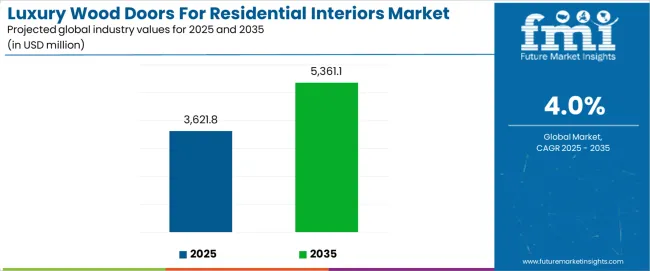
Between 2025 and 2030, the luxury wood doors for residential interiors market is projected to expand from USD 3,621.8 million to USD 4,406.5 million, resulting in a value increase of USD 784.7 million, which represents 45.1% of the total forecast growth for the decade. This phase of development will be shaped by increasing adoption of premium interior design technologies, rising demand for custom door solutions with enhanced aesthetic characteristics, and growing emphasis on luxury home renovation projects with sophisticated craftsmanship requirements. Interior design professionals are expanding their product specification capabilities to address the growing demand for high-end door applications, architectural coordination, and specialty residential interior requirements.
| Metric | Value |
|---|---|
| Estimated Value in (2025E) | USD 3,621.8 million |
| Forecast Value in (2035F) | USD 5,361.1 million |
| Forecast CAGR (2025 to 2035) | 4% |
From 2030 to 2035, the luxury wood doors for residential interiors market is forecast to grow from USD 4,406.5 million to USD 5,361.1 million, adding another USD 954.6 million, which constitutes 54.9% of the overall ten-year expansion. This period is expected to be characterized by the expansion of smart door technologies, the integration of IoT-enabled security systems, and the development of multi-functional door platforms with enhanced luxury features and customization capabilities. The growing adoption of premium home automation practices will drive demand for luxury wood doors with superior design integration and compatibility with home management systems across residential applications.
Between 2020 and 2025, the luxury wood doors for residential interiors market experienced robust growth, driven by increasing demand for premium home improvement solutions and growing recognition of luxury doors as essential elements for sophisticated interior design across high-end residential construction, luxury home renovation, and premium architectural applications. The luxury wood doors for residential interiors market developed as homeowners recognized the potential for luxury wood doors to enhance property values while maintaining exceptional aesthetic appeal and enabling personalized interior design protocols. Technological advancement in wood treatment processes and precision manufacturing mechanisms began emphasizing the critical importance of maintaining design excellence and quality consistency in diverse residential environments.
Market expansion is being supported by the increasing global demand for premium interior design solutions and the corresponding need for luxury door systems that can provide superior aesthetic appeal and design integration while enabling enhanced property values and architectural sophistication across various residential and luxury home applications. Modern residential construction and interior design specialists are increasingly focused on implementing door technologies that can deliver exceptional craftsmanship, prevent design inconsistencies, and provide consistent luxury performance throughout complex interior layouts and diverse architectural conditions. Luxury wood doors' proven ability to deliver exceptional design impact against standard door solutions, enable sophisticated interior coordination, and support premium property positioning make them essential elements for contemporary luxury residential and high-end interior design operations.
The growing emphasis on residential luxury and premium interior design is driving demand for luxury wood doors that can support upscale home requirements, improve interior aesthetics outcomes, and enable sophisticated design integration systems. Homeowners' preference for products that combine exceptional craftsmanship with design versatility and premium materials is creating opportunities for innovative door implementations. The rising influence of luxury home design and premium interior practices is also contributing to increased demand for luxury wood doors that can provide custom design applications, enhanced durability characteristics, and reliable performance across extended operational periods.
The luxury wood doors for residential interiors market is poised for steady growth and transformation. As industries across residential construction, interior design, architectural services, and luxury home renovation seek solutions that deliver exceptional design quality, premium craftsmanship, and architectural sophistication, luxury wood doors are gaining prominence not just as functional elements but as strategic enablers of premium interior design practices and property value enhancement.
Rising luxury home construction in Asia-Pacific and expanding premium interior design initiatives globally amplify demand, while manufacturers are leveraging innovations in wood treatment systems, custom design capabilities, and integrated smart technologies.
Pathways like custom design door platforms, smart-enabled door systems, and specialized architectural solutions promise strong margin uplift, especially in high-end residential segments. Geographic expansion and technology integration will capture volume, particularly where local architectural preferences and luxury interior adoption are critical. Regulatory support around building quality standards, interior design requirements, and residential construction excellence give structural support.
The luxury wood doors for residential interiors market is segmented by product type, wood species, application, price range, distribution channel, and region. By product type, the luxury wood doors for residential interiors market is divided into solid wood doors, composite wood doors, and engineered wood doors. By wood species, it covers oak, mahogany, cherry, walnut, teak, and others. By application, it includes high-end residences, luxury apartments, custom homes, and renovation projects. By price range, the luxury wood doors for residential interiors market is categorized into ultra-premium (>$2,000), premium ($1,000-$2,000), and high-end ($500-$1,000). By distribution channel, it covers specialty retailers, direct sales, online platforms, and trade professionals. Regionally, the luxury wood doors for residential interiors market is divided into North America, Europe, East Asia, South Asia & Pacific, Latin America, and the Middle East & Africa.
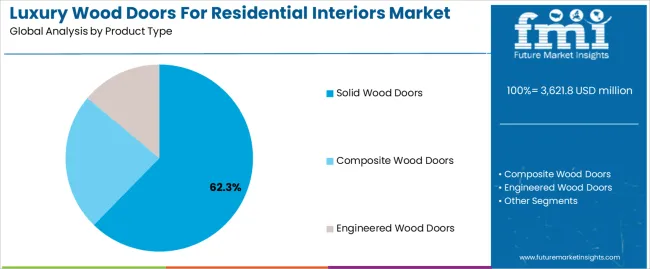
The solid wood doors segment is projected to account for 62.3% of the luxury wood doors for residential interiors market in 2025, reaffirming its position as the leading product category. High-end residential projects and luxury interior designers increasingly utilize solid wood doors for their superior aesthetic appeal when operating across sophisticated interior environments, exceptional craftsmanship characteristics, and premium quality in applications ranging from interior design coordination to luxury architectural element management. Solid wood door technology's advanced manufacturing capabilities and premium material selection directly address the luxury requirements for exceptional quality in high-end residential environments.
This product segment forms the foundation of modern luxury residential construction, as it represents the door type with the greatest design versatility and established market demand across multiple application categories and interior design sectors. Manufacturer investments in premium wood sourcing and advanced finishing compatibility continue to strengthen adoption among interior designers and luxury home builders. With homeowners prioritizing design excellence and quality optimization, solid wood doors align with both aesthetic requirements and luxury positioning objectives, making them the central component of comprehensive premium interior design strategies.
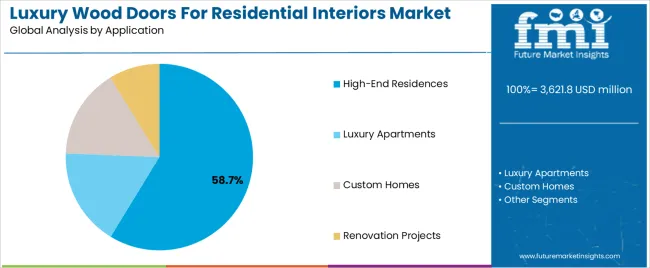
High-end residential applications are projected to represent 58.7% of luxury wood doors demand in 2025, underscoring their critical role as the primary consumers of premium door technology for interior design enhancement, architectural coordination, and luxury home construction applications. Luxury homeowners prefer wood doors for their exceptional design integration capabilities, property value enhancement characteristics, and ability to create sophisticated interior environments while ensuring aesthetic excellence throughout diverse luxury interior programs. Positioned as essential elements for premium residential construction, luxury wood doors offer both design advantages and investment value benefits.
The segment is supported by continuous innovation in custom design technologies and the growing availability of specialized manufacturing systems that enable personalized design applications with enhanced aesthetic appeal and premium quality characteristics. Additionally, high-end residential developers are investing in comprehensive door specification systems to support luxury project requirements and architectural planning. As luxury home demand becomes more prevalent and interior design sophistication requirements increase, high-end residential applications will continue to dominate the end-use market while supporting advanced architectural integration and premium property development strategies.
The luxury wood doors for residential interiors market is advancing steadily due to increasing demand for premium interior design technologies and growing adoption of luxury home improvement solutions that provide superior aesthetic appeal and design integration while enabling enhanced property values across diverse residential and architectural applications. However, the luxury wood doors for residential interiors market faces challenges, including high material costs, skilled craftsmanship requirements, and the need for specialized installation services and quality control programs. Innovation in smart door capabilities and IoT-enabled security systems continues to influence product development and market expansion patterns.
The growing adoption of smart door systems, IoT-enabled access control, and automated security features is enabling manufacturers to produce advanced luxury wood doors with superior technology integration capabilities, enhanced security functionalities, and connected home compatibility. Advanced smart systems provide improved convenience while allowing more sophisticated home automation and consistent performance across various residential applications and technology environments. Manufacturers are increasingly recognizing the competitive advantages of smart door capabilities for premium market positioning and luxury home integration.
Modern luxury wood door producers are incorporating exotic wood species, advanced finishing techniques, and specialized craftsmanship methods to enhance design excellence, enable superior aesthetic outcomes, and deliver premium-quality solutions to luxury residential customers. These innovations improve interior design impact while enabling new aesthetic capabilities, including custom design elements, exceptional material quality, and reduced maintenance requirements. Advanced material integration also allows manufacturers to support comprehensive luxury interior systems and architectural sophistication beyond traditional standard door approaches.
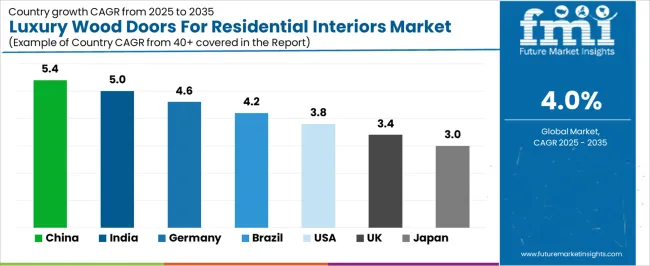
| Country | CAGR (2025-2035) |
|---|---|
| China | 5.4% |
| India | 5% |
| Germany | 4.6% |
| Brazil | 4.2% |
| USA | 3.8% |
| UK | 3.4% |
| Japan | 3% |
The luxury wood doors for residential interiors market is experiencing steady growth globally, with China leading at a 5.4% CAGR through 2035, driven by the expanding luxury residential construction programs, growing premium interior design adoption, and significant investment in high-end property development. India follows at 5%, supported by increasing affluent population, rising luxury home construction demand, and growing premium interior design requirements. Germany shows growth at 4.6%, emphasizing architectural excellence innovation and advanced interior design development. Brazil records 4.2%, focusing on luxury residential expansion and premium home construction modernization. The USA demonstrates 3.8% growth, prioritizing residential design standards and luxury home construction excellence. The UK exhibits 3.4% growth, emphasizing premium interior design adoption and luxury residential development. Japan shows 3% growth, supported by sophisticated interior design initiatives and premium residential construction concentration.
The report covers an in-depth analysis of 40+ countries; seven top-performing countries are highlighted below.
Revenue from luxury wood doors for residential interiors in China is projected to exhibit exceptional growth with a CAGR of 5.4% through 2035, driven by expanding luxury residential construction programs and rapidly growing premium interior design adoption supported by increasing affluent population and high-end property development initiatives. The country's strong position in manufacturing and increasing investment in luxury residential infrastructure are creating substantial demand for advanced luxury wood door solutions. Major property developers and interior design companies are establishing comprehensive door specification capabilities to serve both domestic luxury residential demand and premium construction markets.
Revenue from luxury wood doors for residential interiors in India is expanding at a CAGR of 5%, supported by the country's growing affluent population, expanding luxury residential sector, and increasing adoption of premium interior design solutions. The country's rising disposable income and growing demand for luxury homes are driving requirements for advanced interior design capabilities. International suppliers and domestic manufacturers are establishing extensive production and distribution capabilities to address the growing demand for luxury wood door products.
Revenue from luxury wood doors for residential interiors in Germany is expanding at a CAGR of 4.6%, supported by the country's advanced architectural capabilities, strong emphasis on interior design innovation, and robust demand for high-performance luxury products in residential construction and premium home renovation applications. The nation's mature construction sector and quality-focused operations are driving sophisticated luxury wood door systems throughout the residential industry. Leading manufacturers and design providers are investing extensively in premium materials and advanced craftsmanship technologies to serve both domestic and international markets.
Revenue from luxury wood doors for residential interiors in Brazil is growing at a CAGR of 4.2%, driven by the country's expanding affluent population, growing luxury residential construction, and increasing investment in premium interior design development. Brazil's large residential market and commitment to luxury home construction are supporting demand for sophisticated wood door solutions across multiple residential construction segments. Manufacturers are establishing comprehensive distribution capabilities to serve the growing domestic market and luxury residential opportunities.
Revenue from luxury wood doors for residential interiors in the USA is expanding at a CAGR of 3.8%, supported by the country's advanced interior design sector, strategic focus on luxury residential construction, and established premium home construction capabilities. The USA's residential design leadership and quality integration are driving demand for luxury wood doors in high-end residential construction, custom home building, and premium renovation applications. Manufacturers are investing in comprehensive product development to serve both domestic luxury markets and international premium applications.
Revenue from luxury wood doors for residential interiors in the UK is growing at a CAGR of 3.4%, driven by the country's focus on interior design advancement, emphasis on residential quality, and strong position in premium home construction development. The UK's established architectural innovation capabilities and commitment to luxury residential modernization are supporting investment in advanced door technologies throughout major residential regions. Industry leaders are establishing comprehensive design integration systems to serve domestic luxury construction and premium residential applications.
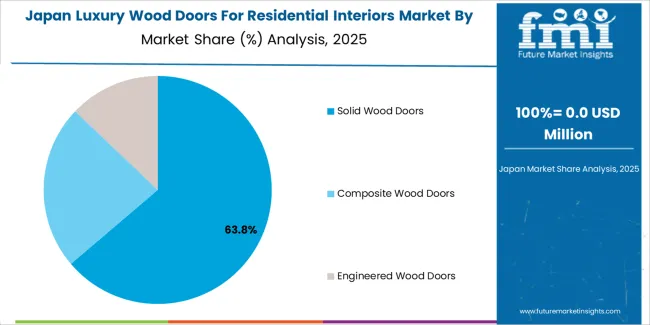
Revenue from luxury wood doors for residential interiors in Japan is expanding at a CAGR of 3%, supported by the country's sophisticated interior design initiatives, growing luxury residential sector, and strategic emphasis on premium construction development. Japan's advanced design capabilities and integrated residential systems are driving demand for advanced luxury wood doors in premium home construction, sophisticated interior design, and high-value residential applications. Leading manufacturers are investing in specialized capabilities to serve the stringent requirements of luxury interior design and premium residential industries.
The luxury wood doors for residential interiors market in Europe is projected to grow from USD 1,313.3 million in 2025 to USD 1,954.2 million by 2035, registering a CAGR of 4% over the forecast period. Germany is expected to maintain its leadership position with a 28.4% market share in 2025, declining slightly to 27.8% by 2035, supported by its strong premium interior design sector, advanced architectural capabilities, and comprehensive luxury residential construction industry serving diverse wood door applications across Europe.
France follows with a 22.1% share in 2025, projected to reach 22.6% by 2035, driven by robust demand for luxury wood doors in premium residential construction, luxury interior design programs, and sophisticated architectural applications, combined with established interior design infrastructure and luxury home expertise. The United Kingdom holds a 19.3% share in 2025, expected to reach 19% by 2035, supported by strong luxury residential sector and growing premium interior design activities. Italy commands a 15.8% share in 2025, projected to reach 16.2% by 2035, while Spain accounts for 8.7% in 2025, expected to reach 9.1% by 2035. The Netherlands maintains a 3.2% share in 2025, growing to 3.4% by 2035. The Rest of Europe region, including Nordic countries, Eastern Europe, Belgium, Poland, and other nations, is anticipated to maintain momentum, with its collective share moving from 2.5% to 1.9% by 2035, attributed to increasing luxury residential construction in Eastern Europe and growing premium interior design penetration in Nordic countries implementing advanced architectural development programs.
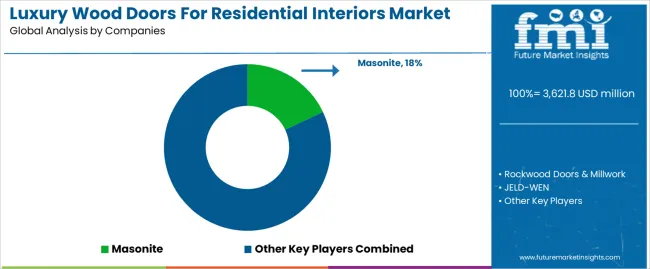
The luxury wood doors for residential interiors market is characterized by competition among established door manufacturers, specialized interior design product producers, and integrated premium residential solutions providers. Companies are investing in advanced craftsmanship research, premium material sourcing, custom design system development, and comprehensive product portfolios to deliver consistent, high-performance, and design-specific luxury wood door solutions. Innovation in smart technology integration, premium material applications, and design excellence enhancement is central to strengthening market position and competitive advantage.
Masonite leads the luxury wood doors for residential interiors market with an 18% market share, offering comprehensive luxury wood door solutions including advanced design capabilities with a focus on residential and premium applications. JELD-WEN provides specialized interior door capabilities with an emphasis on quality manufacturing systems and custom residential operations. Simpson Door Company delivers innovative luxury door products, focusing on premium materials and providing commercial and residential services. TruStile Doors specializes in architectural door solutions and luxury interior technologies for high-end residential applications. Woodport Doors focuses on premium door equipment and integrated residential solutions. TATA Wood Door offers specialized door platforms with emphasis on luxury residential and architectural applications.
| Items | Values |
|---|---|
| Quantitative Units (2025) | USD 3,621.8 million |
| Product Type | Solid Wood Doors, Composite Wood Doors, Engineered Wood Doors |
| Wood Species | Oak, Mahogany, Cherry, Walnut, Teak, Others |
| Application | High-End Residences, Luxury Apartments, Custom Homes, Renovation Projects |
| Price Range | Ultra-Premium (>$2,000), Premium ($1,000-$2,000), High-End ($500-$1,000) |
| Distribution Channel | Specialty Retailers, Direct Sales, Online Platforms, Trade Professionals |
| End-Use Sector | Luxury Homeowners, Interior Designers, Property Developers, Renovation Contractors |
| Regions Covered | North America, Europe, East Asia, South Asia & Pacific, Latin America, Middle East & Africa |
| Countries Covered | China, India, Germany, Brazil, United States, United Kingdom, Japan and 40+ countries |
| Key Companies Profiled | Masonite, JELD-WEN, simpson Door Company, TruStile Doors, Woodport Doors, and TATA Wood Door |
| Additional Attributes | Dollar sales by product type and application category, regional demand trends, competitive landscape, technological advancements in smart door systems, premium material development, design innovation, and architectural integration |
The global luxury wood doors for residential interiors market is estimated to be valued at USD 3,621.8 million in 2025.
The market size for the luxury wood doors for residential interiors market is projected to reach USD 5,361.1 million by 2035.
The luxury wood doors for residential interiors market is expected to grow at a 4.0% CAGR between 2025 and 2035.
The key product types in luxury wood doors for residential interiors market are solid wood doors, composite wood doors and engineered wood doors.
In terms of application, high-end residences segment to command 58.7% share in the luxury wood doors for residential interiors market in 2025.






Full Research Suite comprises of:
Market outlook & trends analysis
Interviews & case studies
Strategic recommendations
Vendor profiles & capabilities analysis
5-year forecasts
8 regions and 60+ country-level data splits
Market segment data splits
12 months of continuous data updates
DELIVERED AS:
PDF EXCEL ONLINE
Luxury Packaging Market Size and Share Forecast Outlook 2025 to 2035
Luxury Rigid Box Market Size and Share Forecast Outlook 2025 to 2035
Luxury Hotel Market Size and Share Forecast Outlook 2025 to 2035
Luxury Electric Vehicle (EV) Market Size and Share Forecast Outlook 2025 to 2035
Luxury Vinyl Tile Flooring Market Size and Share Forecast Outlook 2025 to 2035
Luxury Car Market Size and Share Forecast Outlook 2025 to 2035
Luxury Mattress Market Size and Share Forecast Outlook 2025 to 2035
Luxury Fine Jewellery Market Analysis - Size, Share, and Forecast 2025 to 2035
Luxury SUV Market Size and Share Forecast Outlook 2025 to 2035
Luxury Plumbing Fixtures Market Size and Share Forecast Outlook 2025 to 2035
Luxury Coaches Market Size and Share Forecast Outlook 2025 to 2035
Luxury Interior Fabric Industry Analysis in North America and Europe Growth, Trends and Forecast from 2025 to 2035
Luxury Footwear Market Outlook – Size, Share & Innovations 2025 to 2035
Luxury Furniture Market Insights - Demand, Size, and Industry Trends 2025 to 2035
Competitive Overview of Luxury Yacht Market Share & Providers
Luxury Yacht Industry Analysis by Type, by Size, by Application , by Ownership, and by Region- Forecast for 2025 to 2035
Luxury Handbag Market Analysis by Product Type, Material Type, and Region Through 2035
Market Share Breakdown of Luxury Rigid Box Manufacturers
Market Share Insights for Luxury Packaging Providers
Luxury Perfume Market

Thank you!
You will receive an email from our Business Development Manager. Please be sure to check your SPAM/JUNK folder too.
Chat With
MaRIA